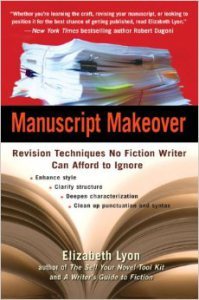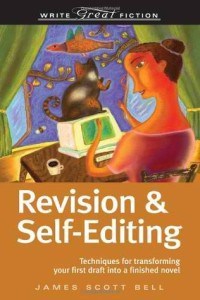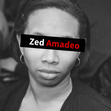How to Edit: 2 Fantastic Guides on Polishing Your Work
Ah, editing – because no first draft can ever be perfect. Despite the challenges involved in this stage of the writing process, editing can be an enjoyable part of the writing process. After all, this is when you get the chance polish your rough draft into a form that approaches your original vision for your work. Elizabeth Lyon’s Manuscript Makeover and James Scott Bell’s Revision and Self-Editing provide helpful strategies on how to edit and improve your story.

A little over two years ago, I came up with the idea for a short fantasy story. I figured I would be done with the manuscript after writing about 40 pages of the story. But even after I wrote what I assumed would be the last word, I kept finding renewed inspiration to continue the experiences of my characters. Before I knew it, I was well into writing the first few stories of my Kindred series. I wrote rough drafts of all of the individual stories one right after another. By the end of that year and a half long period I had spent writing Kindred, I had a massive manuscript that I was proud of but that I knew would need a lot of editing before I was ready to publish the series. Although I had done some editing before, I found myself in need of new guides with advice on how to edit and tackle the challenge of smoothing out a rough manuscript.
Manuscript Makeover by Elizabeth Lyon

Image from Amazon.com
After you finish writing the rough draft of your story, it can be easy to get lost or overwhelmed when trying to edit your work. Elizabeth Lyon’s Manuscript Makeover is a helpful guide to navigating the editing process. Divided up into sections that tackle different aspects of your story, Lyon includes beneficial tips to help make your work the best it can be, with lots of advice on improving structure and flow, characterization, and also some advice on marketing, complete with samples and exercises. I read this guide shortly before I finished my rough draft of the Kindred series and found it invaluable throughout the editing process.
Revision and Self-Editing by James Scott Bell
From Goodreads
I discovered this guide after reading a post on Nat Russo’s post on revising your first draft and requested it from my library immediately afterward. Similar to Manuscript Makeover, Revising and Self-Editing is divided into different sections depending on which aspect of your writing you’re ready to tackle. I found Bell’s book most helpful for creating a solid story structure out of the pieces of my first draft. After reading this guide, I realized that sometimes when I felt that something was off about my story, it was because of issues with how the plot was structured. This guide helped reinforce methods to improve the plot and the flow of my story. Plus this guide has a handy-dandy outline at the end that summarizes each of the sections, useful for reference while in the process of editing.
What I learned about the editing process:
Write a (heavily flawed) first draft:
I have learned to accept that parts of the rough draft aren’t going to make it into the final version of the story that I end up publishing. Parts of my first draft are going to meander away from my original intent for the story. And that’s okay. For me, the point of my first draft is to lay down the bare bones of the story I want to tell. Perfectionism at this stage only serves to paralyze my writing progress. I have to remind myself that even though the draft isn’t great, I’ve probably at least got the skeleton of the story I wanted to tell buried somewhere within. Editing is the process of unearthing that story.
Outlining:
As I go through a quick run-through of my rough draft, I create an outline of the story as it stands. This helps me to identify inconsistencies that I might not have noticed while writing the draft. I then make large changes to the outline, such as switching scenes around or adding new scenes entirely. After the outline is structured properly, I then edit the draft according to the changes I made in the outline.
Stages:
When I first started editing Resurrection, I found myself struggling with making lots of edits on every page, going through each sentence with a fine-toothed comb. Similar to perfectionism, this led to lots of paralysis and editing small items that wouldn’t make it into the final cut of the story (who cares about the grammar of badly written dialogue when you end up cutting that line from the story anyway?). I now do my self-editing in stages: first I do a quick read through, followed by major changes in overall plot structure, and lastly adding particular nuances to character, plot, or theme to enhance the tale.
The great part about self-editing is that you learn mistakes to look out for in your writing style. Even now, I have often found myself incorporating what I learned from these self-editing guides when writing the first draft of other works. This not only helps me preemptively save editing work later on, but improves my writing skills overall.
What strategies or resources have helped you learn how to edit your work?
The post How to Edit: 2 Fantastic Guides on Polishing Your Work appeared first on Zed Amadeo.




